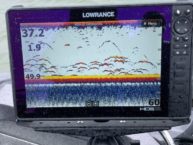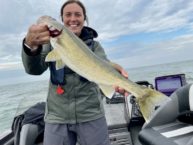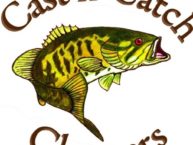“Walleye dreams become a reality every fall here on Devils Lake,” said North Dakota guide and professional angler Johnnie Candle. “All my biggest fish have come in the fall; it’s what I call trophy walleye time.”
Open water fishing usually runs
until mid-November, with all areas of the lake becoming very productive. “The many year-classes of fish are equally distributed, but the 26 to 30 inchers show up now,” the world champion said. Devils Lake has expanded in the past 30 years to some 200,000 acres, consisting of many “lakes within lakes.” He urged anglers to select an area and stick to it, “Launch and fish that piece of Devils Lake. The fish will be there.”
When compared to the heydays of summer, Candle said the typical 100-fish days might drop to 35 walleyes in a day, with most measuring more than 20 inches. “The fish profile changes in fall,” he emphasized. That’s why he breaks ice many mid- to late-November mornings to pound away at the fish.
Candle’s fall walleye fishing has been narrowed down to a few simple points:
** Fish the steepest drops nearest deep water;
** Many of these are flooded road beds;
** 14 to 22 feet of water are good depths;
** Where the steep break meets the mud basin, expect walleyes;
** Roadbeds and main-lake points with rocks can be the best;
** Use a GPS map to locate roads (or watch the shoreline);
** Troll crankbaits – Salmo Hornets, Rapala Shad Raps and Berkley Flicker Shads are tops.
Candle trolls straight behind the boat, trying to keep lures in the exact zone where the steep break transitions to the bottom. “Walleyes love to eat ‘em, and we cover water,” he said. Some of the roadbeds and “spots” run for miles. Watching sonar units helps anglers concentrate and circle back on active schools of trophy walleyes.
Candle also fishes the many bridges, especially when any breeze creates a current flow. He works the downstream side of bridges, vertical jigging with Gulp! or minnows, much like he would in
a river. Deep-water jigging and rigging major points and mid-lake rock humps and transitions (rock to mud) are also popular. “Fall is trophy time,” he said. While fishing for walleyes, he expects to contact numerous pike, with many of the “teeners” eating everything in sight in late October and November.
Al Freidig, past president of the Lake Region Anglers fishing club agreed with Candle and said most of his biggest walleyes come every fall. He favors trolling leadcore with crankbaits on rock piles and ridges of roadbeds. He was instrumental in a community wide effort to create one of the few 4-seasons fish cleaning stations in the country. “This effort involved many organizations, with anglers benefiting tremendously,” he said.
The fish-cleaning station will be open by Christmas, in time for the famous Devils Lake perch ice fishing season. “Hey, walleye and pike anglers flock to Devils Lake when it’s hard, also,” Freidig said. Located just south of Ed’s Bait Shop on Hwy 20 (south of the city of Devils Lake), the 20 x 32 building will be able to handle 15 anglers at one time. It has two grinders, a separate clean-up sink, a handicapped bathroom, will be heated (A/C for summer), plenty of parking for trucks and trailers, will be well-lit, and be accessed with a coded entry.
The code will be available at Ed’s Bait Shop between 6 a.m. to 10 p.m. “Best aspect of the new cleaning facility is that it’s free for all to use!” he said. The Lake Region anglers donated 25 percent of the cost; the North Dakota Game and Fish department added the remainder of the money. The Greater Ramsey Water District did the sewer and water connections. Assistance also came from the Devils Lake Chamber of Commerce, the City of Devils Lake, Ramsey County and the Park Board.
For information on Devils Lake conditions, ramps and/or winter ice conditions and roads, the Jan. 27, 2013 ice fishing tournament, activities, guides, lodging, resorts and restaurants, check www.devilslakend.com, or call 701-662-4903



